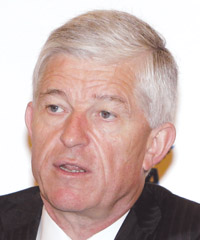Main Story
ATM: Asia-Pacific heads for seamless skies
Over more than two decades Europe’s painful progress towards single skies has become the butt of industry jokes. In the Asia-Pacific, seamless rather than single skies is seen as the answer to bringing maximum efficiency to the fast-growing and geopolitically complex air traffic management systems in the region.
February 1st 2013
Rob Eagles, the International Air Transport Association’s (IATA) Montreal-based director infrastructure implementation, has no illusions about the potential outcome for airlines if steps are not taken to prepare the air traffic management (ATM) system for the thousands of new aircraft that will be flying the region’s already congested airways in coming years. The result, he said, would be gridlock. Read More »
 |
| 'In Asia, each country has its own plans. You’ve got to try and coordinate that and establish some common vocabulary' |
| Andrew Herdman Director General AAPA |
To underline the point, he cited China, where congestion and flight delays are a major cause of passenger angst.
Speaking during a briefing at IATA’s Geneva offices, Eagles showed a simulation of predicted traffic movements at China’s five major airports to 2020 - Bejing, Shanghai Pudong and Hongqiao, Guangzhou and Shenzen - when traffic would be double today’s level.
If nothing was done flight delays could be close to two hours per flight. “Obviously, this is a concern,” said Eagles.
China isn’t the only challenge. IATA traffic forecasts show airlines worldwide expected to welcome some 3.6 billion passengers annually by 2016, 800 million more than the 2.8 billion passengers carried in 2011.
The Asia-Pacific would add 380 million in the same period. Three of the world’s biggest domestic markets would be in Asia: China with 415 million passengers, India 107.2 million and Japan with 93.2 million.
Boeing and Airbus predict more than 12,000 new aircraft will enter Asia’s skies by 2030, more than a third of the world’s total. Huge aircraft orders from the region’s carriers, particularly low-cost operators, are in place. They will arrive as airports, even relatively new facilities, are operating at full capacity.
The problem for the Asia-Pacific, unlike the U.S., which has the Federal Aviation Administration (FAA) and Europe, which has Eurocontrol, is that it has no single regulator.
Instead, the region’s airspace is handled by some 40 separate Air Navigation Service Providers (ANSPs), which will need to forge an unprecedented level of cooperation and coordination if the avalanche of rising traffic is to be handled efficiently.
| 'Airlines have invested millions of dollars buying modern aircraft. But in many places much of the latest avionics equipment can’t be used because the ATC facilities aren’t equipped for the aircraft upgrades' |
Failure to cope will have grave consequences, not only for airlines, but for national economies. It would lead to serious environmental consequences with aircraft flying longer, using more fuel and spewing out more emissions.
For the airlines pressing for more efficient ATM the big issue was fuel, said Association of Asia Pacific Airlines (AAPA) director general, Andrew Herdman. It represents around a third of costs at present.
“This is not so much about the charges by the ANSPs. The big issue from the airline perspective is fuel burn. If you are held in stacking patterns or taking non-direct routes, the fuel burn is a huge factor,” said Herdman.
“Then, of course, there are the emissions. That’s far bigger than any direct savings in terms of aeronautical charges. That’s why the airlines are always urging more rapid progress.”
In Europe, a study by Booz Allen Hamilton, a strategy and technology consulting firm, found the cost of a failure to have integrated services and ATM was around $16 billion annually, with the inefficiency of extended flight paths aircraft had to fly, because of the lack of integration of ATM providers, at about $4 billion. No similar figures are available for the Asia-Pacific, although IATA is conducting an economic analysis to find out.
Not only is the Asia-Pacific a region of highly independent nations with differing cultures that are extremely protective of their airspace sovereignty, it also includes both developed and developing countries with ATM systems that vary significantly. The answer, said IATA, was seamless rather than single skies.
Can the Asia-Pacific outdo Europe in maximizing the efficiency of the region’s ATM and can it do it in time to cope with the projected demand?
 |
| 'Today, ATM faces its biggest challenge – the future. It remains utterly fragmented' |
| Geoff Poole Director General Civil Air Navigation Services Organization |
The prognosis is surprisingly bright. According to Eagles “it may not be as far off as we think”. IATA has agreement in principal between the states in the International Civil Aviation Organization (ICAO) to look at the seamless Asian skies initiative.
How far down the track the initiative has moved became clear last month during an exclusive briefing for Orient Aviation from IATA’s Singapore-based regional director safety, operations and infrastructure, Ken McLean.
A suggested regional ATM road map will be presented to ICAO’s Asia-Pacific Seamless ATM Planning Group (APSAPG) in June this year, he disclosed. “We are deliberately calling this Seamless Asian Skies as opposed to one single sky, looking at the most efficient operation possible between the airspace areas. They can keep their own airspace, we just have to work more efficiently together,” said McLean.
It is a key juncture in the process, which has taken a surprisingly short period of time to move forward. While the issue of rising air traffic demand was widely recognized, IATA presented a paper on behalf of airlines to a conference of the region’s air regulator’s director generals in 2009.
“We clearly said the Asia-Pacific needed to start working on seamlessness as opposed to a single sky. The director generals agreed and asked ICAO’s regional office in Bangkok to consider how we might do that,” said McLean. APSAPG was set up a year later.
There will be challenges. “The problem, as we learned from NextGen [the new U.S. ATM system] and Single European Skies, is that it is easy to construct a road map, the difficulty is implementation and coordination of the different parties involved,” said Herdman.
“In the U.S., at least you have a unified structure under the FAA. The problems in Europe are largely political in nature … we have seen the tussle between the [European] Commission threatening to bring enforcement action because the ANSPs in the individual member states are not living up to their side of the commitments that were made.
“In Asia it’s a different problem. Each country has its own plans. You’ve got to try and coordinate that and establish some common vocabulary.”
| 'The problem for the Asia-Pacific, unlike the U.S., which has the Federal Aviation Administration and Europe, which has Eurocontrol, is that it has no single regulator' |
IATA is convinced the 40 states that make up the region are well on the way to doing just that. “There was recognition from the states that something needed to be done. Everybody sees the numbers and it doesn’t take a rocket scientist to figure out the economic impact,” said McLean.
“The planning group first met in January 2011. The target was to deliver a seamless ATM plan by the middle of 2013. That will happen.”
It has been recognized that no region can formulate its ATM approach in isolation. The Asia-Pacific seamless skies are being designed to fit with ICAO’s own road map for the development of global ATM.
This involves a series of “block upgrades” to be incorporated into its global air navigation plan, which allows for “blocks” of technology to be implemented in a harmonized way by states to ensure ATM improvements can move forward incrementally.
Air traffic control upgrades can no longer be based on national and domestic considerations, said Roberto Kobeh Gonzalez, president of the ICAO Council.
Without consensus the global aviation system would not be able to effectively handle growth projected to climb to six billion passengers a year by 2030, compared with the current 2.7 billion a year.
In that period, ICAO expects the number of annual flights to double to 60 million. Gonzalez said more advanced traffic management techniques would be essential to head off potential gridlock and increased delays in fast-growing regions.
 |
| Rob Eagles, IATA director, infrastructure implementation: Asia-Pacific airways will face gridlock without an ATM overhaul |
Jeff Poole, the director general of the Civil Air Navigation Services Organization (CANSO), has also called on the international aviation community to embrace change to achieve a globally harmonised air navigation system.
“Today, ATM faces its biggest challenge – the future,” he said, adding that ATM “remains utterly fragmented”. The fragmentation impacted on safety, operational and cost efficiency, capacity and had adverse effects on the environment, said Poole.
Said IATA’s McLean: “We [in Asia] have been fortunate because we have been able to draw on everything that is happening globally. The timing is fantastic. ICAO has been wrestling for a number of years with how to harmonize NextGen and CESAR (Single European Sky ATM Research) programmes.
“That’s where they came up with the aviation block upgrades, which are a methodology of implementing this capability that we need to manage the traffic in a structured way across the world.
“The theory is if you have a consistent road map and all of the states around the world refer to it, then you’ll start to get some harmonization.”
Herdman believes ICAO and IATA are playing strong roles in pressing the shift from individual “brand names”, such as NextGen and Single European Skies. This will mean more focus on the underlying technologies, which can be used “as a tool, regardless of which region in the world, so the individual countries, or whoever’s managing the airspace, can move ahead knowing that it will all fit together,” he said.
Herdman also pointed to recent moves by ICAO and IATA to strengthen their teams of experts in locations such as Bangkok, Singapore and Beijing. “That’s good because you need the resources and experts available to enable the discussion to move from talking about road maps to making definite steps along the way,” he said.
While details of the draft road map for Asian seamless skies have not yet been released it is likely to prioritize areas where initial action is required. “The ICAO Asia-Pacific region includes China and Mongolia, India and the Pacific. Unlike Europe and the U.S. where traffic is concentrated in a smallish area, the Asia-Pacific has pockets of airspace which are very densely flown, but vast areas where nothing much happens,” said McLean.
| Passenger flights per month per region (extrapolated) |
 |
| Source: Global Media Day |
“If you look down the spine of Asia-Pacific, from China through Japan, the South China Sea, the Philippines, Indonesia, Singapore and Thailand, that’s where the growth is going to come. It is possible the seamless ATM plan will say let’s focus on where we think the greatest problem will arise in future.”
In addition to IATA and ICAO, CANSO is also heavily involved in the project. IATA has been briefing the Asia-Pacific Economic Cooperation group (APEC) and the Association of South East Asian Nations (Asean), which is heading for a single aviation market in 2015.
Airports are involved because seamless air traffic operations are impossible without sufficient airport infrastructure on the ground to support it.
McLean said Asia needs a central flow management unit, or CFMU, similar to the system in Europe. It takes all the state data, looks at it and decides where the problems will be. But the states still manage the traffic, not the CFMU.
“That’s what will happen in Asia-Pacific in the first instance,” said McLean. While separate from seamless skies, it is a key component of a future system. IATA has run sessions on such airport collaborative decision-making across the region, including India, the Philippines and Indonesia.
Indeed Singapore, Hong Kong and Thailand have an agreement for coordinated Airport Collaborative Decision Making (A-CDM) between airport locations. Primarily linked to surface management – providing departure information to airlines – the plan is to expand into the airspace structure.
IATA wants to see Japan, Malaysia, Indonesia and Vietnam involved. The Civil Aviation Administration of China and its Air Traffic Management Bureau have plans to implement a nationwide air traffic flow management system to accommodate that country’s rapid traffic growth.
 |
| 'We are deliberately calling this Seamless Asian Skies as opposed to one single sky, looking at the most efficient operation possible between the airspace areas' |
| Ken McLean Regional Director, Safety, Operations & Infrastructure Asia-Pacific IATA |
Ultimately, one huge benefit from seamless skies and technology upgrades will be the resolution of a long-term airline issue. They have invested millions of dollars buying modern aircraft with the latest avionics, but much of the equipment can’t be used because, in many places, the ATC facilities aren’t equipped for the aircraft upgrades.
“When you operate a smart phone, you turn it on in Dubai, Delhi, Berlin or Buenos Aires and it works,” said McLean.
“But when you buy a $200 or $300 million aeroplane with all its sophisticated equipment you can’t use it at many of the ANSPs because they don’t have the capability enabled. It depends on whether the government has invested in the ground capability.
“You have sophisticated countries [in Asia] which have the agenda, the knowledge, the technology, the background drivers and good traffic management infrastructure where everything will work fine.
“Then you cross a border somewhere and the next one doesn’t. You go from a six-lane highway to a two-lane bridge. You are delivering traffic to the traffic jam, the same as on a motorway.
“Our focus is to enable most of this capability across the Asia-Pacific, using all that capability consistently.”
The AAPA’s Herdman said: “In the past, we’ve had situations where the airlines were ahead of the game in terms of new equipment on aircraft and new technology. But as the ANSPs didn’t match the pace of implementation with ground-based equipment, airlines were stung. Essentially, a lot of the equipment on board the plane was never used effectively.
“From our point of view, we want harmonization and standardization so they can equip aircraft and operate anywhere in the world. We don’t want contradictions between the U.S. approach, the European approach and what happens in Asia.”
But overall, IATA’s Eagles said the key to success was doing it in a managed way “with key stakeholder engagement, working to pre-defined targets and technology upgrades”.
“It has got to be a complete, co-ordinated effort that includes airline planning and scheduling, air space capabilities to cope, collaborative decision-making, flow management and airport capacity capability,” he said.